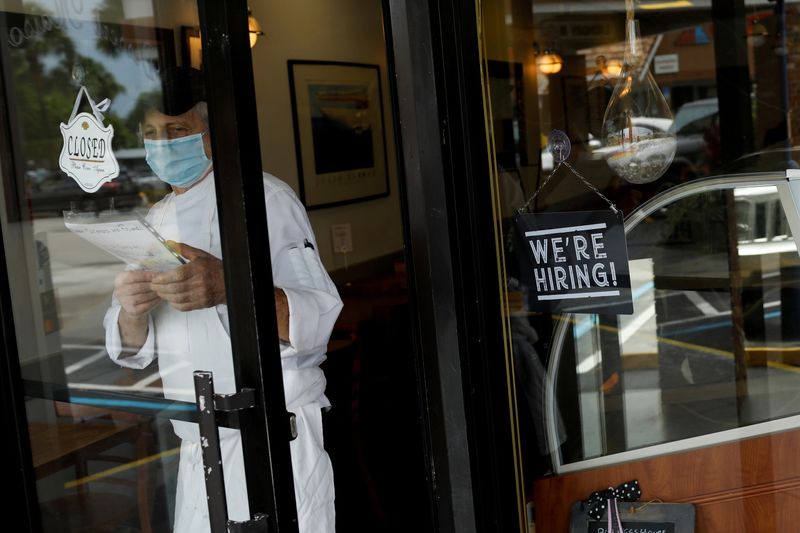By Lucia Mutikani
WASHINGTON – The number of Americans filing new claims for unemployment benefits fell moderately last week, still suggesting that April was another month of strong job growth.
The report from the Labor Department on Thursday also showed unemployment rolls shrinking to the lowest level in 52 years in the first week of April, reinforcing the tightening labor market conditions. An acute shortage of workers is keeping layoffs low, helping to fuel inflation, and forcing the Federal Reserve to adopt a restrictive monetary policy stance.
The U.S. central bank faces a tricky balancing act of slowing demand without plunging the economy into recession. So far, households continue to spend and businesses are hungry for workers to meet consumer demand.
But trouble could be brewing, with other data on Thursday showing a measure of future business activity in the mid-Atlantic region tumbling in April to a level last seen 14 years ago, when the economy was in the throes of the Great Recession.
“Economic growth may eventually hit a wall without more workers for companies to hire, but not today,” said Christopher Rupkey, chief economist at FWDBONDS in New York. “Jobless claims at near-record lows mean worker wages will continue to go up and up, guaranteeing that inflation remains more persistent and at more worrisome levels for longer than Fed officials believe.”
Initial claims for state unemployment benefits declined 2,000 to a seasonally adjusted 184,000 for the week ended April 16. Economists polled by Reuters had forecast 180,000 applications for the latest week. Claims plunged to a more than 53-year low of 166,000 during the week ending March 19.
There is probably limited scope for further declines.
Last week, applications tumbled by 7,656 in Missouri. There were also substantial declines in Ohio, Texas, New York and Michigan, which offset increases in Connecticut and California.
The Fed in March raised its policy interest rate by 25 basis points, the first rate hike in more than three years. Economists expect a half-percentage-point rate increase next month, and for the U.S. central bank to soon start trimming its asset holdings.
Claims, which have dropped from a record high of 6.137 million in early April 2020, will be closely watched for signs of whether rising borrowing costs are curbing demand.
Stocks on Wall Street were higher. The dollar slipped against a basket of currencies. U.S. Treasury prices fell.
WORKER SHORTAGE
Demand for labor is holding strong for now. The Fed’s Beige Book, based on information collected on or before April 11 from the central bank’s business contacts, showed on Wednesday that “demand for workers continued to be strong across most districts and industry sectors,” but noted “hiring was held back by the overall lack of available workers.”
There were a near record 11.3 million job openings at the end of February. The unemployment rate is at 3.6%, just one-tenth of a percentage point above its pre-pandemic level.
But there are signs labor supply will soon improve. The claims report showed the number of people receiving benefits after an initial week of aid dropped 58,000 to 1.417 million during the week ending April 9. The was the lowest level for the so-called continuing claims since February 1970.
The demand-supply imbalance is stoking wage inflation. A second report from the Philadelphia Fed on Thursday showed 80% of firms in the mid-Atlantic region reported wages and compensation costs had increased over the past three months.
A majority of firms in the region that covers eastern Pennsylvania, southern New Jersey and Delaware, said they had adjusted their 2022 budgets for wages and compensation since the beginning of the year, with 65% reporting they were planning to increase wages and compensation by “more than originally planned,” and a third intending “to increase wages and compensation sooner than originally planned.”
The Philadelphia Fed’s business activity index dropped to 17.6 this month from 27.4 in March. A reading above zero indicates expansion in the region’s manufacturing sector.
Manufacturers’ assessment of business activity over the next six months was downbeat, with the index dropping 15 points to 8.2, the lowest reading since December 2008.
Still, firms hired more workers, with the survey’s gauge of factory employment reaching an all-time high. Companies planned to retain their workforces over the next six months.
Last week’s claims data covered the period during which the government surveyed business establishments for the nonfarm payrolls component of April’s employment report. Claims rose marginally between the March and April payrolls survey periods.
Economists are expecting strong employment growth in April. Payrolls increased by 431,000 jobs in March, marking the 11th straight month of employment gains in excess of 400,000.
“The labor market remains in excellent shape as the spring quarter begins,” said Stuart Hoffman, senior economic advisor at PNC Financial in Pittsburgh, Pennsylvania.
(Reporting by Lucia Mutikani; Editing by Paul Simao and Andrea Ricci)
